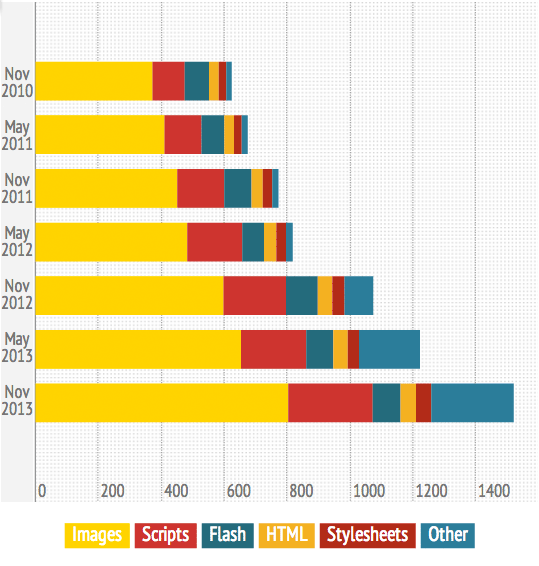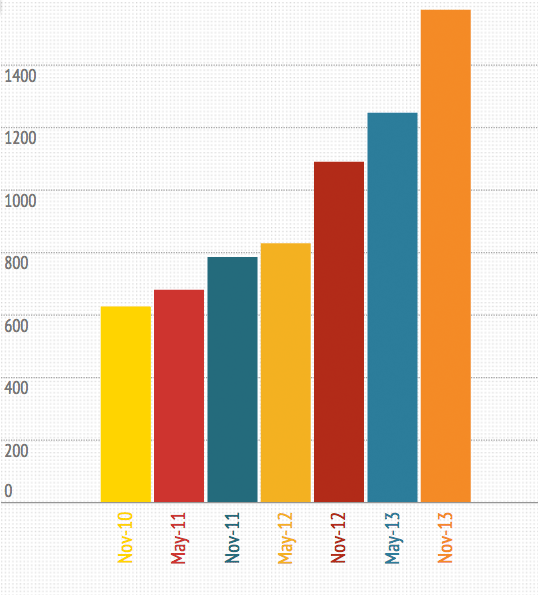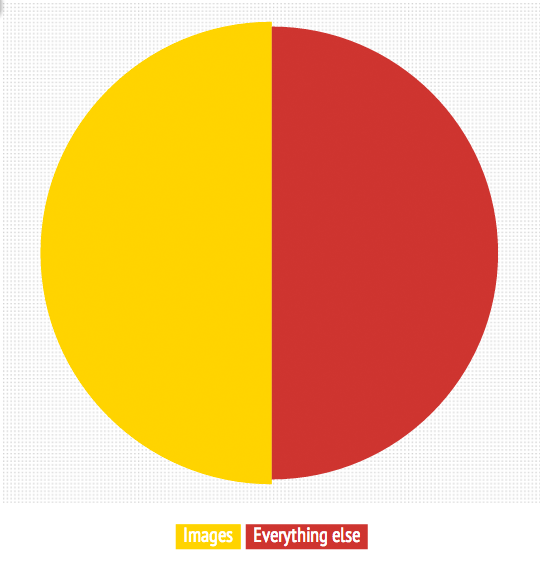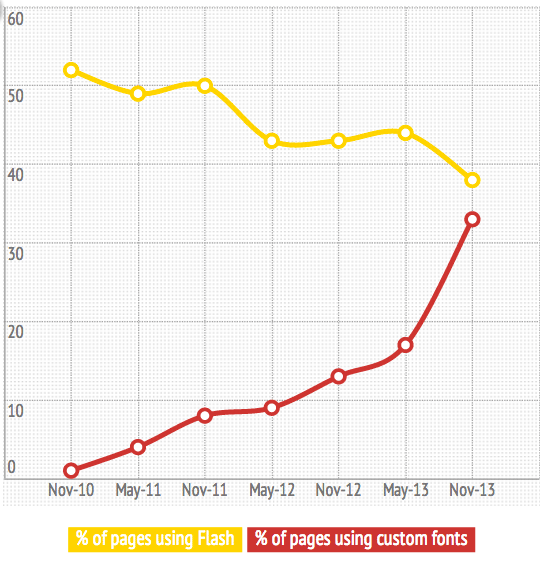The average web page has grown 151% in just three years
I had intended to write about the results of Radware’s new EEG research into mobile usability, but I just realized that the HTTP Archive recently celebrated its third anniversary (happy birthday, HTTP Archive! Your card is in the mail!), making this a good time for our semi-annual look at page size and composition.
As you may or may not know, we’ve been reporting on the HTTP Archive data for the top 1,000 sites since the Archive’s inception in 2010. Over the years, we’ve learned one thing, definitively…
Pages keep getting bigger. And bigger. AND BIGGER.
The newest Archive data backs this up — and how. Here’s the latest snapshot of how the average page has changed, in terms of size and composition, in the past three years.

If this graph doesn’t alarm you, it should. Here’s why.
1. The average top 1,000 web page is 1575 KB.
Last spring, the average page was 1246 KB. This represents a 26% increase in total page size in just six months, and a 151% increase in three years.
 At this time last year, we conjectured that this growth could be partially attributed to “holiday bloat” — when site owners try to stuff as much content on to their pages as possible in anticipation of Black Friday. Looking at this graph is enough to disprove this theory, but it’s interesting to note that, if you take a stepwise look, there are consistent payload bumps that happen every fall.
At this time last year, we conjectured that this growth could be partially attributed to “holiday bloat” — when site owners try to stuff as much content on to their pages as possible in anticipation of Black Friday. Looking at this graph is enough to disprove this theory, but it’s interesting to note that, if you take a stepwise look, there are consistent payload bumps that happen every fall.
Page growth is a major reason why we keep finding, quarter after quarter, that pages are getting slower. And faster networks are not a cure-all for the challenges of page bloat. If I had a dollar for every time I heard or read someone say that page bloat isn’t an issue because networks are getting faster… well, I’d have a lot of dollars. Yes, networks are getting faster, but not at the pace we need. According to Akamai’s most recent quarterly State of the Internet report, the global average connection speed among the top 50 internet-using countries is 3.3 Mbps — a 5.2% increase over the previous quarter. But when we’re seeing year-over-year page growth ranging from 45-50%, it’s easy to see that the gap is widening.
2. More than half of this page size is due to images.
A whopping 804 KB per page is comprised of images. Three years ago, images comprised just 372 KB of a page’s total payload.
 This gets talked about a lot, but it bears repeating: images are one of the single greatest impediments to front-end performance. All too often, they’re either in the wrong format or they’re uncompressed or they’re not optimized to load progressively — or all of the above. It doesn’t have to be this way.
This gets talked about a lot, but it bears repeating: images are one of the single greatest impediments to front-end performance. All too often, they’re either in the wrong format or they’re uncompressed or they’re not optimized to load progressively — or all of the above. It doesn’t have to be this way.
3. Flash is on the decrease. Custom fonts are on the increase.
Today, 38% of pages use Flash, compared to 52% in 2010. This is a good thing. Nothing against Flash, per se, but if Apple has no plans ever to support it, its obsolescence is inevitable in our increasingly mobile-first world.
On the flip side, use of custom fonts has exploded — from 1% in 2010 to 33% today. Much of this growth has happened in the past six months: in May of this year, custom font usage was just 17%, meaning usage has almost doubled in a very short time frame. Custom fonts are pretty. I like them. But custom fonts have a dark side: they can incur a significant performance penalty. There are techniques to mitigate this penalty, but many people don’t use them. (If this is you, get some good tips here and here.)

Conclusion: Performance must engage with design and UX
Since the inception of the HTTP Archive, each time I get ready to look at these stats, I expect that this will be the time when page growth will have plateaued — or at least show signs of slowing down. I feel like, in our world, we spend such an incredible amount of time talking about the importance of making pages smaller and simpler, this must be having some effect on the outside world. But it’s hard to see this effect when looking at these numbers. On one hand, these stats mean that none of us are going to be out of work any time soon. On the other hand, I have to confess it’s a bit disheartening.
But I’m an optimist, and I feel that we’re finally, slowly, making much-needed inroads to the worlds of design and user experience. We need to advance those inroads. We recognize the importance of devops (development + operations) in relation to web performance. We also need to talk about the intersection of development and user experience (devUX?) if we’re going to take on the last mile.
